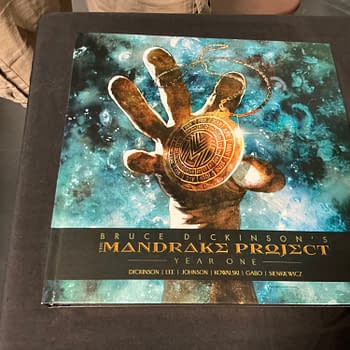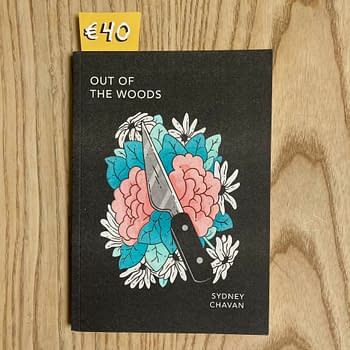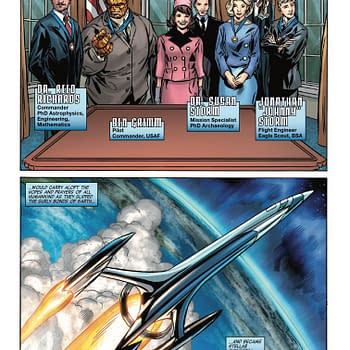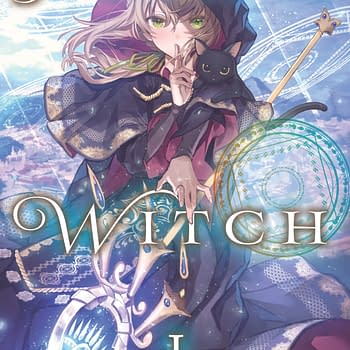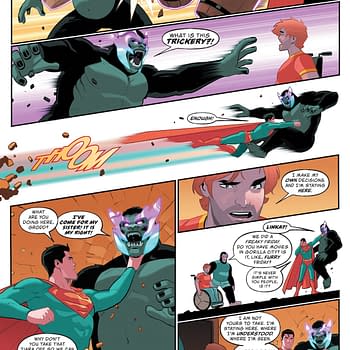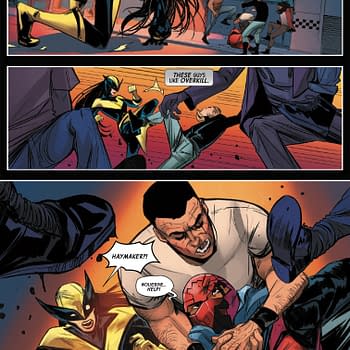Posted in: Comics | Tagged:
Gamifying Comics: The Making Of Cartooner
by Jason Bradley Thompson
If I was stranded alone on a desert island and had to choose between tabletop games and comics to take with me, I wouldn't be able to choose. (If I was stranded with my wife, I'd definitely choose games.) Among games, I love creative games: RPGs, improv, anything that encourages imagination and creates stories to retell after the game is done. And considering the popularity of both comics & games, isn't it weird that there aren't more games about comics?
My answer to this is Cartooner, a game I codesigned with my wife Jumana Al Hashal, currently on Kickstarter until December 18! Cartooner is a game where you make comics; the only comic-making tabletop game I know (except for one other game which I'll mention later).
In Cartooner, you play artists competing for Fame (what else?) by drawing comics on pre-printed Comic Pages. Like any comic artist, you've got deadlines: there's four timed rounds of five minutes each, and each round you draw a page. If you can't draw, like most people, don't worry; this isn't a 'judge game' where the other players judge you on your art! Instead, it's about communication. You get Fame Points by expressing your three core Themes, drawn from 136 Theme Cards with subjects ranging from Sharks to Car Chases to Desire to Rule the World. Best of all, unlike in, say, Pictionary, you can use words. (But not too many; you get bonus points if you don't use too many Word Balloons.) You draw an awesome shark? Great, 1 Fame. You wrote the word "shark"? Great, 1 Fame. If you want to spend time showing off and drawing an awesome shark, go for it, but it won't give you a higher score.
The basic rules are simple. But starting in round two, once you're an established cartoonist, there's a new layer of strategy: Trend Cards. Trends are things that fans want, such as Disasters, Mystery, Medical drama, Superheroes or Noir Each of 52 Trends adds to the victory conditions by giving you Fame for doing certain things. If Nature is trendy, for instance, you get 1 bonus Fame for each panel showing animals or plants. If Mystery is trendy, the player who writes the most sentences ending with questions ("Who did it? Why? Where did they come from?") gets 5 bonus Fame for that round.
Trends are fleeting, of course, and each round they change…and multiply. As the game moves to round three and round four, players have to deal with more and more Trends—and more complicated Comic Pages!—in the same amount of time. In addition to testing your creativity, it's a test of speed as you try to strategically do as much as you can before time runs out. It's also fun seeing what happens to people's stories when they change them to chase Trends ("My comic is about a hardboiled detective, but Funny Animals are trendy…"): a game version of the eternal artist's struggle between chasing your dreams and selling out.
Like many real games, such as the wizards & orcs on a tactical WWII battlefield that became D&D, Cartooner started out as a joke. Back in 2011 in Seattle I was hanging out in Café Mox, a new board game café, while also reading Bakuman, a meta-manga about hardworking manga artists struggling for success. "I bet I could make a funny game about the struggle to succeed as a comic artist!" I thought. With help from my wife and codesigner Jumana Al Hashal, I whipped up a first draft to entertain some friends that weekend. It was goofy at first (the first draft had D&D-like statistics and a roleplaying game aspect where you RP'ed starving artists holed up in their apartment) but the basic concept of speed-drawing a comic in five minutes turned out to be fun. We decided to make a second draft and cut away the parts that didn't work. Jumana's experience in UI/UX for mobile apps helped make a tighter and better game. Rules gradually changed and improved. That was the beginning of a six-year playtest period that led to our first game, Mangaka: The Fast & Furious Game of Drawing Comics, published in Spring this year by Japanime Games.
I'd worked as an editor at VIZ, and my wife and I met because of shared interest in manga, so I gave Mangaka a Japanese theme as a tribute to Japanese comics. But after years of playtests at conventions, libraries and art schools, with players age 8 to 55, we realized that the core drawing-and-gaming appeal of Mangaka was bigger than otaku in-jokes about kaiju, mecha and body pillows (much as I love all these things). From the moment we started developing Mangaka, one of the first questions people asked was: what about American comics? From the beginning I was thinking of an 'American expansion pack', making lists of American comics Themes and tropes. After another year of playtesting, we realized there was so much to play with, an expansion wouldn't be enough. Mangaka became Cartooner, an entirely new, stand-alone game with original Trends and Themes.
That's how two nerds' love of games and comics became a game about comics. Cartooner is a standalone game, but we made it backwards-compatible with Mangaka, so you can mix elements from the two great comic traditions. Though the basic rules are the same, the extra playtesting let us streamline and tweak things to make the core game even better. Throw in the great art of Konstantin Pogorelov, and we're proud of all the time we spent on it since that fateful day in 2011 when we bought playing cards at the dollar store and wrote on them with sharpies to turn them into game cards.
For some gamers, the first round of Cartooner is intimidating, but once they've jumped into the deep end of the pool and started drawing, they realize that this is a game about quick wits and not drawing ability. For myself, I like the play Cartooner as a creative exercise and story generator. And while crazy stories of what happened at the gaming table are often a "you had to be there" thing, with Cartooner the evidence stays right there, drawn in pen or pencil as a record of exactly how weird your Mutant Lizard Surfer comic got when Language Police became trendy. And who knows, just like D&D campaigns have inspired bestselling fantasy novels and anime, maybe someday an idea that started out as a 5-minute comic might become the next Netflix TV series…that is, if they get enough Fame.
To Kickstart Cartooner we need to raise $25,000 by December 18. If we reach $4000 over the weekend (by Monday 11/21), I'll do a special comic for Bleeding Cool, drawn using the Solo Cartooner Rules, based on Themes chosen by Bleeding Cool readers!! (Write your Themes suggestions in the comments section of this article.) Thanks for reading, and please support our Kickstarter!
Jason Bradley Thompson is a game designer, storyboard artist and illustrator. As a manga editor for VIZ, he edited Shonen Jump magazine and wrote the Eisner-nominated Manga: The Complete Guide. His comic work includes the graphic novel series King of RPGs (with Victor Hao) and H.P. Lovecraft's Dream-Quest of Unknown Kadath and Other Stories. His art has appeared in tabletop games such as Lamentations of the Flame Princess, Call of Cthulhu and Dungeons and Dragons.












